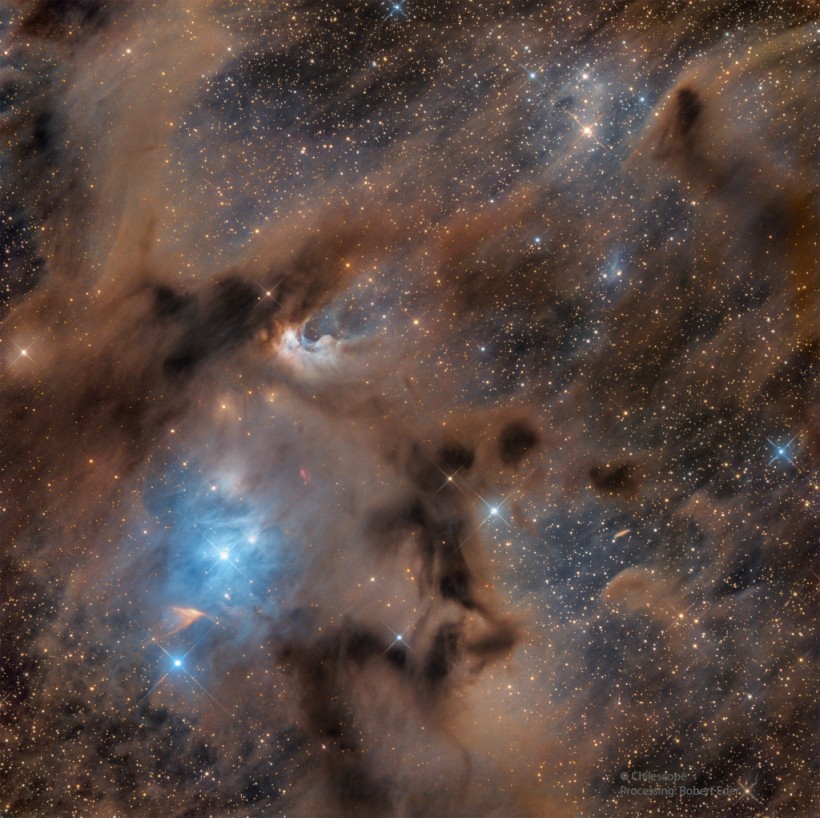Using NASA's James Webb Space Telescope (JWST), scientists spotted and measured the coldest ice yet detected in the deepest depths of an interstellar molecular cloud.
Researchers report in their study published in the journal Nature Astronomy that the frozen molecules could reach up to -440 degrees Fahrenheit (-263 degrees Celsius).

A wispy blue cloud of molecular gas glows from the light of distant stars in this James Webb Space Telescope image
Birthplace for Stars and Planets
Stars and planets, including habitable planets like Earth, are born in molecular clouds, which are made up of frozen molecules, gasses, and dust particles. Live Science reports that the team of scientists utilized the JWST's infrared camera to explore the molecular cloud Chameleon I located around 500 light-years from Earth.
The scientists discovered frozen compounds in the Chameleon I, such as carbonyl sulfur, ammonia, methane, methanol, and others. Researchers said that these chemicals will someday be a component of the heated core of a developing star or future exoplanets. They also include the building components of habitable worlds: carbon, oxygen, hydrogen, nitrogen, and sulfur (COHNS).
Melissa McClure, an astronomer at Leiden Observatory in the Netherlands and the lead author of the study, said in a statement in the press release that the findings provide insights into the initial, dark chemistry stage of ice in dust grains in space that will soon grow into centimeter-sized pebbles and later on planets.
She added that this is the first time researchers were able to study the composition of the pre-stellar ice near the molecular cloud's center. Detecting methanol suggests that the stars and planets would eventually form from this cloud and inherit the molecules, which also means that the prebiotic molecules in planetary systems are common even in the Solar System.
READ ALSO: NASA James Webb Space Telescope Captures 18 Twinkling Stars After Pointing In 'Right Direction'
Importance of Dust Grains and Ices in the Formation of Habitable Planets
Chameleon I and other molecular clouds form as diffuse patches of dust and gas, as per Space.com. Ices containing the building blocks of life develop on the surfaces of dust grains. As the clouds form clusters of gas and star formation occurs, these ices develop in bulk while remaining coated on the dust grains.
Many of the chemical processes required to build complex molecules required for life speed up when they occur on a solid surface, such as a dust grain, rather than in a gaseous state. That means dust grains serve as important catalysts for basic organic components to develop into complex compounds that can eventually constitute the building blocks of life.
Furthermore, the volatile nature of these ices allows them to zap back into gases as stars develop and temperatures rise. The discovery of these pure ices within Chameleon I allows scientists to track the path of compounds from dust grains to being lodged in the cores and atmospheres of future stars and exoplanets.
Webb's data has given much information to scientists to study, like the elements within Chameleon I that are more abundant than previously believed. They only detected 1% of expected sulfur, 19% of predicted oxygen and carbon, and 13% of nitrogen. Researchers said that these elements may have been trapped in other ices that are unobservable in the wavelengths the team was using.
RELATED ARTICLE: James Webb Space Telescope Detects Sonic Boom Larger Than Milky Way Resulting From Galactic Invasion
Check out more news and information on Space in Science Times.














